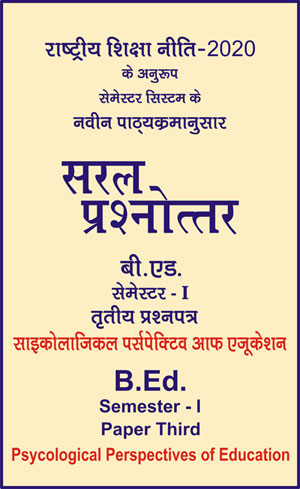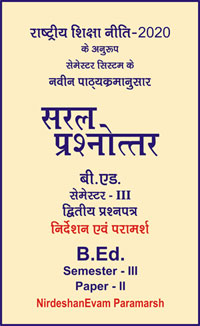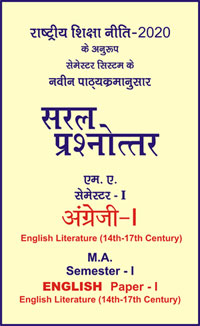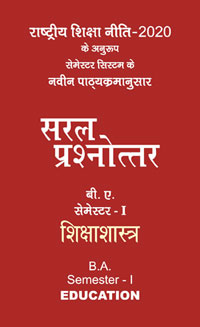|
बी एड - एम एड >> बी.एड. सेमेस्टर-1 प्रश्नपत्र-III - साइकोलाजिकल पर्सपेक्टिव आफ एजूकेशन बी.एड. सेमेस्टर-1 प्रश्नपत्र-III - साइकोलाजिकल पर्सपेक्टिव आफ एजूकेशनसरल प्रश्नोत्तर समूह
|
|
|||||||
बी.एड. सेमेस्टर-1 प्रश्नपत्र-III - साइकोलाजिकल पर्सपेक्टिव आफ एजूकेशन (अंग्रेजी भाषा में)
Theories of Personality
-
There are .......... trait dimensions did Cattell propose?
(a) 2
(b) 3
(c) 16
(d) 117 -
Which of the following are the aim of behavioural genetics is to learn about :
(a) The possibility of eradicating behavioural problems in children
(b) The ability of animals to learn the language
(c) The extent to which geneticists can modify people's behaviour
(d) The genetic and environmental influences on human behaviour -
Which of the following characteristics describe someone who, according to Maslow, is self-actualized?
(a) Creativity
(b) Confidence
(c) Spontaneity
(d) All of the above -
Which of the following is not a defence mechanism?
(a) Ingratiation
(b) Regression
(c) Projection
(d) Sublimation -
The MMPI is used to measure :
(a) Leadership potential
(b) The Big Five traits
(c) Personality and psychological disorders
(d) Unconscious drives -
Which of the following would NOT be useful to a behavioural geneticist?
(a) Case studies
(b) Family studies
(c) Adoption studies
(d) Twin studies -
Which one best describes a person, who is sensitive and intellectual? William Sheldon suggested that body build was associated with personality traits.
(a) Endomorph
(b) Neurotic
(c) Conservative
(d) Ectomorph -
Sheldon proposed the traits that would best describe a football player would be :
(a) Ectomorph
(b) Endomorph
(c) Mesomorph
(d) Activomorph -
One trait that dominates a personality so much that it influences nearly everything a person does is a :
(a) Global trait
(b) Central trait
(c) Specific trait
(d) Cardinal trait -
.......... is an external, unstable attribution for why something happens to a person?
(a) Hard work
(b) Bad mood
(c) The weather
(d) Fate -
Which of the following is the Humanistic psychologists embraced the idea of :
(a) Repression
(b) The id
(c) Unconscious drives
(d) Free will -
Adler described that Someone who feels as though they are not living up to expectations would be :
(a) An inferiority complex
(b) Low self-realization
(c) An adlerian complex
(d) Low actualization -
Ideas, thoughts, or memories of which we are not immediately aware, but which we can think about with reasonably little effort, are said by Freudians to be stored in our .......... level of awareness.
(a) Immediate
(b) Unconscious
(c) Preconscious
(d) Subconscious -
Freud might "explain" war and man's inhumanity toward man in terms of :
(a) Thanatos
(b) Libido
(c) Wish-fulfillment
(d) Eros -
The aspect or structure of one's personality that is most responsible for feelings of guilt or blame is the :
(a) Id
(b) Superego
(c) Libido
(d) Ego -
Otis did not take the time to study for his test in psychology and, as a result, failed it badly. Otis blames the instructor for asking so many “picky” questions and blames the author of his text for writing such a “poor and useless” book. It sounds like Otis is engaging in :
(a) Repression
(b) Fantasy
(c) Projection
(d) Rationalization -
The so-called Neo-Freudians left Freud and devised their own theories of personality because they objected to - more than anything else - Freud’s heavy emphasis on :
(a) Instincts and biological concepts.
(b) The importance of early childhood.
(c) Parent-child social interactions.
(d) The idea of levels of consciousness. -
The concept of “inferiority complex” is best associated with :
(a) Freud
(b) Jung
(c) Adler
(d) Horney -
More so than any other theorists discussed, psychologists such as Watson, Dollard, Miller, and Skinner tended to talk about personality in terms of :
(a) Conscious choices made by individuals faced with difficult decisions to make.
(b) Explaining a person’s behaviors by referring to environmental factors.
(c) Personality traits that remained relatively stable once they were formed.
(d) Cognitive representations of the world that guide one’s behaviors. -
Which of these is the most valid criticism of the behavioral approach to personality?
(a) It emphasizes the environment so much, there is little left for the inner, individual person.
(b) It relies too heavily on concepts borrowed from biology and physiology.
(c) Focusing on only one level of consciousness, it leaves out much of the rich fabric of unconscious processes.
(d) Most of the terminology of this approach is very loosely defined. -
To say that a personality theory is phenomenological is to say that it emphasizes :
(a) Instinctive, biological mechanisms.
(b) How people see themselves and their environments.
(c) Unconscious, unknown and unknowable influences.
(d) Learning and conditioning. -
Personality traits have been defined most commonly :
(a) In terms of how one’s personality is tied to survival.
(b) To describe how someone scores on a personality test.
(c) To explain individual differences among people.
(d) By statistical procedures such as factor analysis. -
In the context of personality theories, what makes the Big Five so remarkable?
(a) The five major theorists involved have agreed on what personality is.
(b) We now can determine when the environment is most important and when personality is most important.
(c) There seems to be a consensus on how best to describe personality.
(d) There are actually five levels of consciousness, not just the three that Freud described. -
Which concept can best describe how the so-called “person-situation” debate has been resolved?
(a) A no-win situation
(b) Useless or pointless
(c) Evolutionary
(d) Interactionism -
If we hear someone talking about “dispositional traits” and “situational traits” to what is she or he referring?
(a) Nature/nurture
(b) Internal forces/external forces
(c) Growth/development
(d) Male issues/female issues -
According to Freud, the first time one becomes aware of and finds pleasure in one’s own genitals is when one enters the .......... stage of development, at about the age of three years.
(a) Sexual
(b) Latency
(c) Phallic
(d) Genital -
For which of these assertions is there the most evidence?
(a) Males are more physically aggressive than are females.
(b) Males are more analytical in their thinking than are females.
(c) Females are more creative in their problem solving than are males.
(d) Females are generally more sociable than are males. -
As opposed to intellectual assessment, personality assessment :
(a) Seldom uses psychological tests.
(b) Attempts to measure you at your best.
(c) Is used to predict behavior.
(d) Measures normal, or typical, behaviors. -
To say that a test, such as the MMPI-2, is “criterion referenced” implies that :
(a) Questions do not have right or wrong answers.
(b) People from different known groups respond to items differently.
(c) The test is designed to predict who might become mentally ill in the future.
(d) Test scores have been factor analyzed. -
The test in which one is assumed to project his or her personality into descriptions of ambiguous inkblots is the :
(a) Thematic apperception test.
(b) Minnesota multiphasic personality inventory.
(c) Rotter incomplete sentences test.
(d) Rorschach test.
|
|||||

 i
i 










